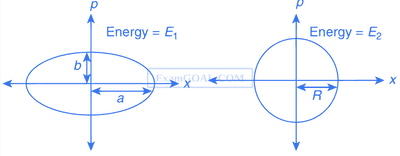Simple Harmonic Motion · Physics · JEE Advanced
MCQ (Single Correct Answer)
As shown in the figures, a uniform rod OO' of length l is hinged at the point O and held in place vertically between two walls using two massless springs of same spring constant. The springs are connected at the midpoint and at the top-end (O') of the rod, as shown in Fig. 1 and the rod is made to oscillate by a small angular displacement. The frequency of oscillation of the rod is f₁. On the other hand, if both the springs are connected at the midpoint of the rod, as shown in Fig. 2 and the rod is made to oscillate by a small angular displacement, then the frequency of oscillation is f₂. Ignoring gravity and assuming motion only in the plane of the diagram, the value of $ \frac{f_1}{f_2} $ is:

A small block is connected to one end of a massless spring of un-stretched length 4.9 m. The other end of the spring (see the figure) is fixed. The system lies on a horizontal frictionless surface. The block is stretched by 0.2 m and released from rest at t = 0. It then executes simple harmonic motion with angular frequency $$\omega$$ = ($$\pi$$/3) rad/s. Simultaneously, at t = 0, a small pebble is projected with speed v from point P at an angle of 45$$^\circ$$ as shown in the figure. Point O is at a horizontal distance of 10 m from O. If the pebble hits the block at t = 1 s, the value of v is (take g = 10 m/s2)

The phase space diagram for a ball thrown vertically up from ground is
The phase space diagram for simple harmonic motion is a circle centred at the origin. In the figure, the two circles represent the same oscillator but for different initial conditions, and E1 and E2 are the total mechanical energies respectively. Then

Consider the spring-mass system, with the mass submerged in water, as shown in the figure. The phase space diagram for one cycle of this system is


If the total energy of the particle is E, it will perform periodic motion only if
For periodic motion of small amplitude A, the time period T of this particle is proportional to
The acceleration of this particle for $$|x| > {X_0}$$ is
The mass M shown in the figure below oscillates in simple harmonic motion with amplitude A. The amplitude of the point P is

A uniform rod of length L and mass M is pivoted at the centre. Its two ends are attached to two springs of equal spring constants $$k$$. The springs are fixed to rigid supports as shown in the figure, and the rod is free to oscillate in the horizontal plane. The rod is gently pushed through a small angle $$\theta$$ in one direction and released. The frequency of oscillation is

The $$x$$-$$t$$ graph of a particle undergoing simple harmonic motion is shown in the figure. The acceleration of the particle at $$t=4/3$$ s is

Column I gives a list of possible set of parameters measured in some experiments. The variations of the parameters in the form of graphs are shown in Column II. Match the set of parameters given in Column I with the graphs given in Column II. Indicate your answer by darkening the appropriate bubbles of the 4 $$\times$$ 4 matrix given in the ORS.
| Column I | Column II | ||
|---|---|---|---|
| (A) | Potential energy of a simple pendulum (y-axis) as a function of displacement (x) axis | (P) |  |
| (B) | Displacement (y-axis) as a function of time (x-axis) for a one dimensional motion at zero or constant acceleration when the body is moving along the positive x-direction | (Q) |  |
| (C) | Range of a projectile (y-axis) as a function of its velocity (x-axis) when projected at a fixed angle | (R) |  |
| (D) | The square of the time period (y-axis) of a simple pendulum as a function of its length (x-axis) | (S) |  |
Numerical
On a frictionless horizontal plane, a bob of mass $m=0.1 \mathrm{~kg}$ is attached to a spring with natural length $l_{0}=0.1 \mathrm{~m}$. The spring constant is $k_{1}=0.009 \,\mathrm{Nm}^{-1}$ when the length of the spring $l>l_{0}$ and is $k_{2}=0.016 \,\mathrm{Nm}^{-1}$ when $l < l_{0}$. Initially the bob is released from $l=$ $0.15 \mathrm{~m}$. Assume that Hooke's law remains valid throughout the motion. If the time period of the full oscillation is $T=(n \pi) s$, then the integer closest to $n$ is __________.
MCQ (More than One Correct Answer)
(i) when the block is at x0; and
(ii) when the block is at x = x0 + A.
In both cases, a particle with mass m( < M) is softly placed on the block after which they stick on each other. Which of the following statement(s) is(are) true about the motion after the mass m is placed on the mass M?

A student performed the experiment to measure the speed of sound in air using resonance air-column method. Two resonances in the air-column were obtained by lowering the water level. The resonance with the shorter air-column is the first resonance and that with the longer air-column is the second resonance. Then,